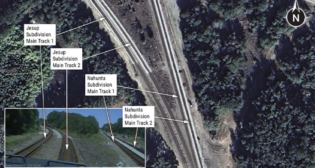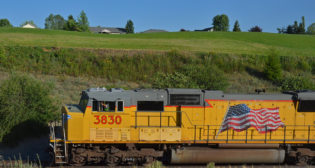
130 years of innovation: Union Switch & Signal/Ansaldo STS USA (1881-2011)
Written by William C. Vantuono, Editor-in-ChiefThe Union Switch & Signal Company, known today as Ansaldo STS USA, and Railway Age have been partners since our company was founded by George Westinghouse in 1881. In 2011, we marked 130 years of continuous business activities, much like the magazine marks 155 years of continuous publication.
Through page after page of editorial content and advertising, our company’s long, storied history has been chronicled in this magazine as well in the specialty signaling and communications magazines once published by the Simmons-Boardman Railway Division.
The earliest references to US&S in Railway Age I’ve come across are two United States patents issued on April 26, 1881, to George Westinghouse: 240.628, BLOCK SIGNALING APPARATUS; and 240.629, SWITCH AND SIGNAL APPARATUS. Both were published with diagrams and full descriptions in the June 16, 1881 issue. The former is described as “a block system in which the signals are operated by a hydraulic column set in motion by compressed air acting upon a flexible diaphragm.” For the latter, “Switches and their corresponding signals are actuated through hydraulic columns extending from one side of flexible diaphragms to the switch or signal operating mechanism, said columns being set in motion by compressed air acting upon the opposite side of the diaphragms.”
Though these descriptions are complicated, compared to the microprocessor-controlled interlockings Ansaldo STS USA designs and builds today, their pneumatic technology seems rather crude. But for its time, it was remarkably effective. It enabled huge advances in railroad operational safety. Actually, the principles behind its design and operation really haven’t changed all that much in 130 years. They are still based on safety. That’s what we’re all about at Ansaldo STS USA. Whether we are designing an interlocking controller for a 10,000-foot siding on a freight railroad or a fully automated train operation system for a rail transit agency, the fail-safe conditions of our systems are paramount to our engineering solutions.
Most important are our people and customers. The technological know-how embedded in Ansaldo STS USA is today, as in the past 130 years, our critical differentiator, the legacy of our highly skilled group of professionals working closely with our customers, defining new applications while enhancing operational safety and competitiveness. Our professional engineering teams always approach railway signaling and communications as a discipline, and as an applied science. They have driven innovation in what we do since US&S’s founding on May 5, 1881, and today are creating more industry firsts—as you will learn about in this publication—than ever before.
I feel very fortunate to have crowned my professional career as the final serving President and CEO of Union Switch & Signal and to be part of a distinguished roster of predecessors, beginning with our founder, George Westinghouse.
This special, commemorative report prepared for us by Railway Age provides a glimpse into our company’s glorious past as well as a look ahead to what we believe to be a very bright, dynamic future serving a resurgent global railway industry.
Alan E. Calegari, Ph.D., former president and CEO, Ansaldo STS USA, Inc.
When the legendary George Westinghouse founded the Union Switch & Signal Company—today’s Ansaldo STS USA—in 1881, he had already made a major impact on railroad safety with his invention, at age 22, of the air brake system in 1869. Westinghouse received a patent for his fail-safe air brake system, which today remains the foundation of train braking. It was just one of many firsts for Westinghouse, and the companies he founded to manufacture and sell his inventions.
The Union Switch & Signal story is also one of many firsts (see the timeline on these pages). The innovations that have come from this 130-year-old railway supplier and the numerous talented engineers behind its technology continue to advance railway signaling and control systems, and in turn, railway safety. George Westinghouse passed on in 1914, but his engineering acumen and entrepreneurial spirit live on in Ansaldo STS USA.
US&S technology has been chronicled in Railway Age and its ancillary publications in the signaling and communications field since the company’s beginning. Following the invention of the AC track circuit in 1903, the company secured a major contract for signaling the first segment of New York City’s subway system, at the time one of the largest, most complex civil engineering projects in the world.
From the December 25, 1903 edition of Railway Age, a major milestone: “The Union Switch & Signal Company has secured the contracts for the Interborough Rapid Transit Company of New York. The Westinghouse electro-pneumatic system is to be installed on the first named, but a new feature is to be introduced, that of using alternating current. The signals will be controlled by alternating current, through relays that are sensitive to alternating current only, and which will not be affected by the direct current used for train service in the subway.”
One of the most significant advancements in railway signaling was US&S’s 1923 introduction of automatic train control, which was based on the company’s system of inductive continuous track circuit control. ATC, as it is commonly called today, was first described in the March 1922 issue of Railway Signal Engineer:
“The Union Switch & Signal Company’s automatic train control system is of the continuous induction type, designed to be applicable to direct or alternating current track circuits and to roads using electric propulsion as well as for use where both steam and electricity are used as motive power. It has been developed with the idea that [ATC] should be an adjunct to, and not a substitute for, wayside signals. The system is designed for use with a speed control feature, but by the omission of such parts as pertain specifically to speed control, an automatic stop device is obtained which incorporates in it the features of continuous track circuit control. This system provides the means for applying the brakes if a train passes a caution signal, and in addition provides a valve in the engine cab which can be operated easily by the engineman to prevent the train speed being unduly restricted by a brake application, provided the engineman operates it before passing a caution signal. Thus, at each caution signal, he is given the opportunity to show that he is awake and alert, and by doing so, retains control and the responsibility for control of the train. If the engineman fails to acknowledge the caution signal by the operation of the valve, the train is stopped, requiring him to be alert at each caution signal.”
Thus, we have the beginnings of ATC—and now PTC—with overspeed control, penalty brake application, and an alerter/acknowledger function. Today, though microprocessors provide much the same functions, the safety principles remain unchanged.
The Pennsylvania Railroad was US&S’s first customer for the new technology. As RSE reported in detail in August 1922, the PRR ordered a continuous induction, full-speed train control system on 45 miles of single track and five miles of double track between Lewistown and Sunbury, Pa.: “Alternating current track circuits and position light signals will be installed at the same time. This will require that a 4,400-volt, single-phase, 60-cycle transmission line be built. Speed control apparatus is being applied to eight freight and four passenger locomotives. This will be the first extensive installation working on the continuous induction principle. This system requires that a signal be transmitted to a train to permit it to proceed, while non-receipt of a signal results in stopping of the train. As continuous track circuit protection is installed, this provides that the train will be under control at all times, occupying or entering the main track equipped with the installation. No apparatus is required along the roadway, as rails are used to conduct the signaling current which operates the engine apparatus, and the switch opened ahead of the train or another train backing into the block will cause the apparatus to be applied immediately. This system will provide against excessive and dangerous speed being attained and is designed with the intention of at no time relieving the engineman of responsibility for proper handling of his train.”
Railway Age reported on Aug. 4, 1923, that the system was fulfilling its potential to improve safety: “The results thus far obtained have been extremely encouraging and justify hopes that the system may provide a successful of the problem of preventing collisions automatically, regardless of human failures.”
ATC was well under way, and it wasn’t long before other railroads wanted the technology. In late 1923, RSE reported that the Atchison, Topeka & Santa Fe ordered a system for its 101-mile, double-track main line between Ft. Madison, Iowa and Chillicothe, Ill., “in which each track will be equipped for both normal and reverse running. This installation involves equipping approximately 125 engines. In addition to the above, it is understood that US&S has contracts for installations on other roads which will include both steam and alternating current propulsion and the installation of the train control system superimposed on DC track circuits.”
By the 1930s, many railroads had started to replace semaphore signals with color-searchlight signals. One installation, on the Erie main line, solved a critical “Bottle Neck” problem, as described in the June 30, 1934 edition of Railway Age: “To provide increased capacity on a two-track section between four-track lines, the Erie has installed searchlight-type automatic signals, using four aspects, to replace old semaphore signaling between Suffern, N.Y. and Newburgh Junction, a distance of 14 miles. The line follows the Ramapo River through a mountainous territory, which would involve a heavy expenditure for the construction of additional tracks. So far, the new signaling arrangement has permitted the present traffic of 60 trains daily to be handled without delays and is, therefore, highly satisfactory.”
Centralized traffic control took a major leap forward with US&S’s 1966 introduction of CAD (computer aided dispatching). In 1968, the Pittsburgh & Lake Erie had installed US&S CTC on its entire 180 miles of main line, and “streamlined,” as Railway Signaling & Communications reported in October 1967, “from a four- and three-track main line to double- and single-track mains,” including 80 miles of bi-directional running. It featured pushbutton-operated entrance/exit routing. But more important, the entire system was computer-controlled. Though primitive by today’s standards, PL&E’s CAD was revolutionary and highly effective for its time:
“A solid-state, high-speed type 549 code system will be used to send controls from Pitt Tower control machine to each of the field stations over a wire pair on the pole line or in cable. This duplex system will continuously scan these stations and transmit indications to Pittsburgh. The system is arranged to handle 400 bits per second, which is equivalent to 600 words per minute teletypewriter operation. In a typical operation, the system will be able to scan and receive reports from all 18 field locations between Pisstburgh and Youngstown (Ohio) in 5 seconds. The importance of such speed and capacity can be appreciated by considering that more than 3,500 switch movements and signal clearings will be required in a 24-hour period.”
Today, the latest evolution of CAD technology is Ansaldo STS USA’s real-time OTP (Optimizing Traffic Planner), which gives dispatchers a far more proactive role in routing trains and planning for service disruptions, breakdowns, and other incidents that can negatively impact operations.
Speed, capacity, and—most important—safety: These goals have been the foundation of railway signaling and communications for generations. They’ve been behind every technological revolution or evolution that Ansaldo STS USA/Union Switch & Signal has brought to the global railway industry during the past 130 years.
Union Switch & Signal Firsts
1871 William Robinson invents the first DC track circuit. Seven years later, he founds Union Electric Signal Company, which merges with George Westinghouse’s company, Interlocking Switch & Signal Company, in 1881, to create Union Switch & Signal.
1903 The first AC track circuit and vane relay. George Westinghouse wanted to use alternating current to provide power to the railroads. US&S engineer Jacob Baker Struble invents the first vane relay for track circuits. Using AC power allowed track circuit length to be extended. The track circuit later becomes part of Struble’s invention of the AC system of automatic block signaling (ABS).
1923 The first continuous cab signaling system, which provides an electrical signal through the rails. Onboard cab signal equipment picks up signals through an antenna and decodes the information so the locomotive engineer can see signal indications without having to see wayside signals.
1923 Vacuum tube technology is applied to railroad signaling. US&S takes vacuum tube technology and uses it to amplify a signal to make a track circuit longer or to change power from AC to DC. Previously, vacuum tubes were used only for telephone, telegraph, or radio communications.
1924 The first automated remote control gravity hump yard. All yard switches and retarders can be operated remotely from a hump tower in the yard.
1926 The first copper oxide rectifier. This is a small device that converts AC power to DC power to charge batteries and provide power for other applications such as railroad circuits and logic. The invention leads to the inventions of the control diode, the transistor, and the microprocessor.
1934 The first coded track circuit. This uses the rails to transmit coded pulses of electricity that reduce outside electrical interference. It allows signal detection in longer track lengths and improves the sensitivity of the signal that detects the train. It also provides codes that tell the engineer the maximum speed on a particular section of railroad, and allows the signal system to enforce that speed.
1966 The first computer aided dispatching system. CAD provides dispatchers with information on train location, speed, estimated time of arrival, and many types of fault detection.
1970 The first digital classification yard control system. A yard can now be controlled by a single computer system, instead of many individual manual systems. The system uses radar equipment to determine when and how many cars are arriving and departing a yard.
1985 The first vital microprocessor interlocking control. MicroLok® contains a central processing unit (CPU), a power supply, and input/output cards, much like a home computer.
1986 The first video projection railroad territory display. This technology displays traffic control information to an entire dispatching center. It allows all dispatchers and supervisors in the room to monitor where all the trains are located at any given time.
1998 The first consolidated transit control center, for the Massachusetts Bay Transportation Authority. This system combines MBTA’s rail and bus lines into a single control center.
2001 The first microprocessor-based circuit controller, the part of a switch machine that tells a control center when the machine has safely completed a switch point movement. US&S’s microprocessor-based ECC™ (Electronic Circuit Controller) has no moving parts and thus is more reliable and requires far less maintenance than its mechanical predecessor.
2002 The first completely driverless metro system, for Copenhagen, Denmark. US&S designs an onboard computer and a computerized train dispatch center called Advanced Train Control that replaces the need for an engineer. The system starts and stops trains, opens and closes train doors, and controls train speed and braking as well as train separation.
2005 The first real-time Optimizing Traffic Planner (OTP), a CAD program that integrates all possible routes and looks at the amount of rail traffic at any given point so that a dispatcher can plan for the best possible solution to route trains in case of a breakdown or other service disruption, or changes in usual operating patterns.



